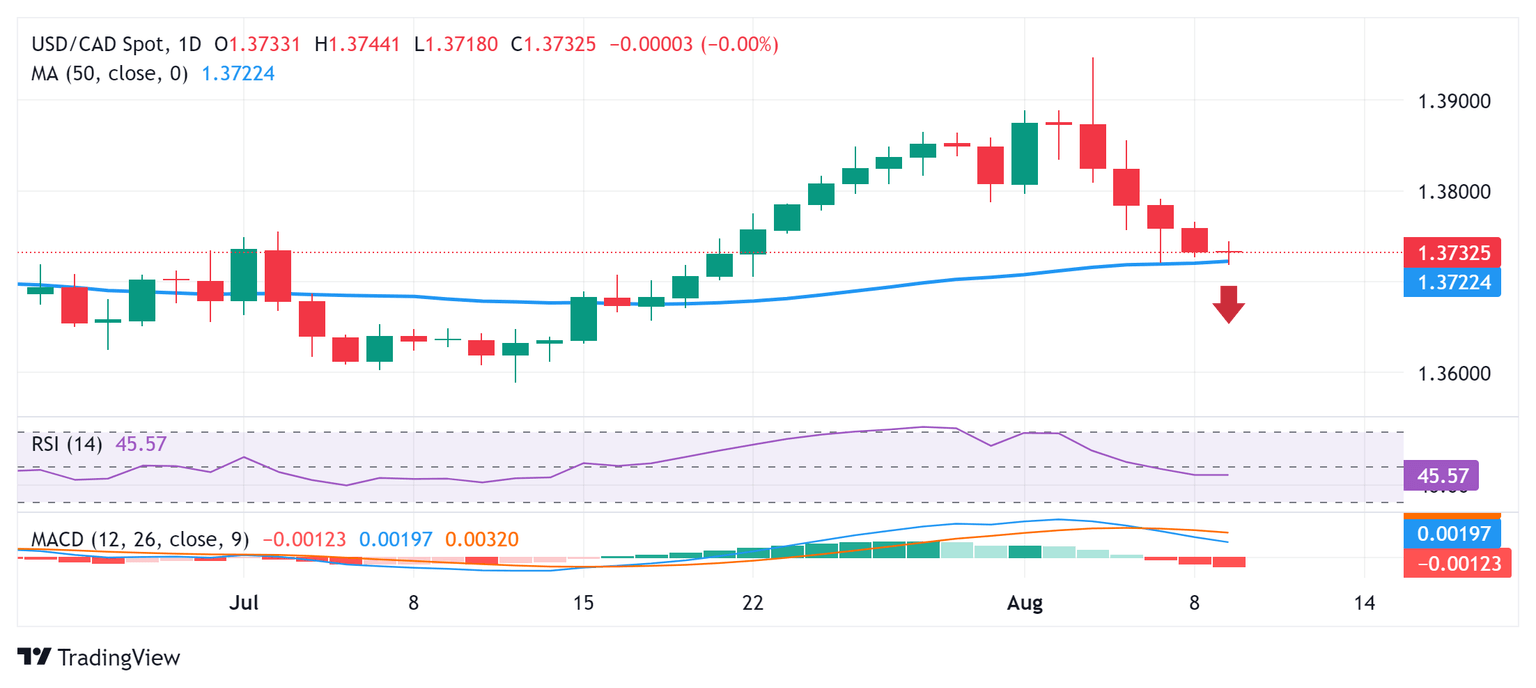USD/CAD Price Prediction: Defends 50-day SMA support above 1.3700 ahead of Canadian jobs data
- USD/CAD bounces off a multi-week low touched this Friday, albeit lacks follow-through.
- An uptick in Oil prices underpins the Loonie and acts as a headwind amid a softer USD.
- Traders also seem reluctant to place aggressive bets ahead of the Canadian jobs report.

The USD/CAD pair once again finds some support near the 50-day Simple Moving Average (SMA) and stages a modest bounce from the 1.3720-1.3715 region, or a three-week low touched earlier this Friday. Spot prices, however, struggle to capitalize on the move and remain below mid-1.3700s through the first half of the European session.
Meanwhile, the uptick lacks any obvious fundamental catalyst and could be solely attributed to some repositioning trade ahead of the release of Canadian monthly employment details. Any meaningful recovery, however, still seems elusive in the wake of the recent rise in Crude Oil prices, which tends to underpin the commodity-linked Loonie. Furthermore, the emergence of some US Dollar (USD) selling, led by a fresh leg down in the US Treasury bond yields, further contributes to capping gains for the USD/CAD pair.
From a technical perspective, oscillators on the daily chart have just started gaining negative traction and support prospects for an extension of the recent sharp pullback from the vicinity of the mid-1.3900s, or the highest level since October 2022 touched on Monday. Bearish traders, however, might wait for a sustained break and acceptance below the 50-day SMA pivotal support before placing fresh bets. The USD/CAD pair might then weaken further below the 1.3700 mark and test the 1.3680-1.3675 support zone.
The downward trajectory could extend further towards the mid-1.3600s en route to the 1.3600 round figure. The latter coincides with the technically significant 200-day SMA, which if broken decisively will be seen as a fresh trigger for bearish traders and pave the way for a further near-term depreciating move.
On the flip side, the overnight swing high, around the 1.3765 region, could act as an immediate hurdle ahead of the 1.3800 mark. A sustained strength beyond will suggest that the corrective decline witnessed since the beginning of the week has run its course and prompt an aggressive short-covering move. The USD/CAD pair might then climb to the 1.3845-1.3850 intermediate hurdle before aiming for the 1.3900 mark. Nevertheless, spot prices remain on track to register weekly losses for the first time in the previous four.
USD/CAD daily chart
Canadian Dollar FAQs
The key factors driving the Canadian Dollar (CAD) are the level of interest rates set by the Bank of Canada (BoC), the price of Oil, Canada’s largest export, the health of its economy, inflation and the Trade Balance, which is the difference between the value of Canada’s exports versus its imports. Other factors include market sentiment – whether investors are taking on more risky assets (risk-on) or seeking safe-havens (risk-off) – with risk-on being CAD-positive. As its largest trading partner, the health of the US economy is also a key factor influencing the Canadian Dollar.
The Bank of Canada (BoC) has a significant influence on the Canadian Dollar by setting the level of interest rates that banks can lend to one another. This influences the level of interest rates for everyone. The main goal of the BoC is to maintain inflation at 1-3% by adjusting interest rates up or down. Relatively higher interest rates tend to be positive for the CAD. The Bank of Canada can also use quantitative easing and tightening to influence credit conditions, with the former CAD-negative and the latter CAD-positive.
The price of Oil is a key factor impacting the value of the Canadian Dollar. Petroleum is Canada’s biggest export, so Oil price tends to have an immediate impact on the CAD value. Generally, if Oil price rises CAD also goes up, as aggregate demand for the currency increases. The opposite is the case if the price of Oil falls. Higher Oil prices also tend to result in a greater likelihood of a positive Trade Balance, which is also supportive of the CAD.
While inflation had always traditionally been thought of as a negative factor for a currency since it lowers the value of money, the opposite has actually been the case in modern times with the relaxation of cross-border capital controls. Higher inflation tends to lead central banks to put up interest rates which attracts more capital inflows from global investors seeking a lucrative place to keep their money. This increases demand for the local currency, which in Canada’s case is the Canadian Dollar.
Macroeconomic data releases gauge the health of the economy and can have an impact on the Canadian Dollar. Indicators such as GDP, Manufacturing and Services PMIs, employment, and consumer sentiment surveys can all influence the direction of the CAD. A strong economy is good for the Canadian Dollar. Not only does it attract more foreign investment but it may encourage the Bank of Canada to put up interest rates, leading to a stronger currency. If economic data is weak, however, the CAD is likely to fall.
Author

Haresh Menghani
FXStreet
Haresh Menghani is a detail-oriented professional with 10+ years of extensive experience in analysing the global financial markets.


















